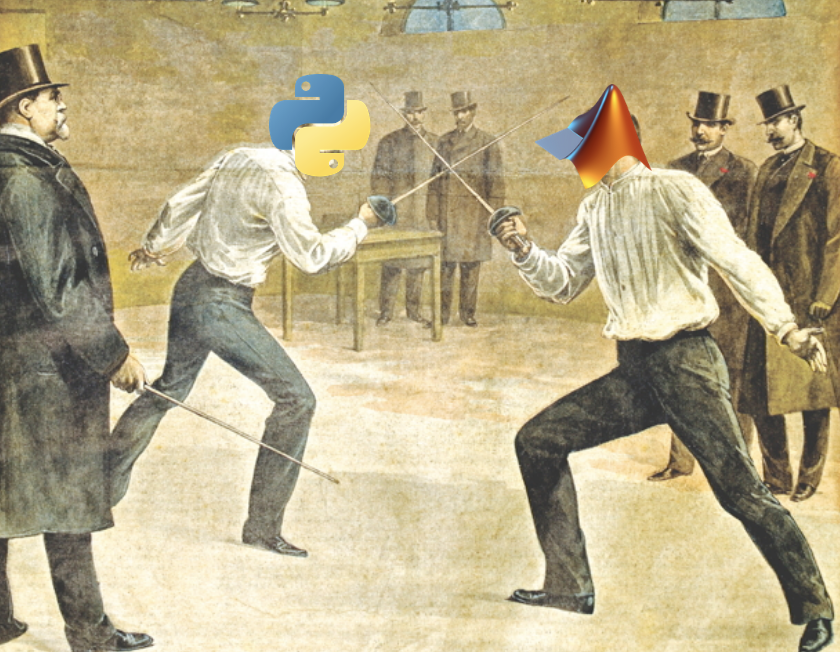MATLAB vs Python for Engineers and Scientists
 Harry Munro
Harry MunroTable of contents

I was first introduced to MATLAB during my mechanical engineering university days, where my attempts to grapple with it were, to put it mildly, rather pitiful. Its utility eluded me until the real world of industry presented its case in compelling terms.
MATLAB proved invaluable for automating the data analysis of diesel systems we were rigorously testing and developing. Its sophisticated toolsets enabled us to decipher performance metrics, optimise processes, and streamline the development workflow.
Meanwhile, a cohort of colleagues were dabbling in something called Python — a concept as foreign to me as a kettle in a coffee shop. Their zeal for Python was infectious, extolling its virtues of open-source accessibility and the liberating absence of price tags.
MATLAB and Python stand as titans in the realm of scientific computing and engineering, each wielding its unique arsenal of features. Deciding between them is less about allegiance and more about aligning with the nuances. Let's delve into the intricacies that distinguish these two powerhouses.
The Feature Comparison Table
| What | MATLAB | Python |
| Support for Matrix Operations | MATLAB (Matrix Laboratory) was specifically designed for matrix operations and numerical computing. It offers extensive built-in support for vectorized operations, making it easier and more intuitive to perform complex mathematical computations. | Python, with the NumPy library, offers powerful support for large, multi-dimensional arrays and matrices, along with a large collection of high-level mathematical functions to operate on these arrays. While MATLAB is designed inherently for matrix operations, Python's NumPy library is highly optimized for performance and can handle numerical computing tasks efficiently. |
| Tools | MATLAB provides a wide range of toolboxes that are specifically tailored for different engineering and scientific applications, including signal processing, control systems, neural networks, and more. These toolboxes are professionally developed, rigorously tested, and regularly updated. | Python has a vast ecosystem of libraries for different applications, similar to MATLAB's toolboxes. For instance, SciPy for scientific computing, Matplotlib for plotting, Pandas for data analysis, and Scikit-learn for machine learning. These libraries are open source and freely available. |
| Simplicity and Speed of Development | MATLAB's high-level language and desktop environment are designed for iterative exploration, design, and problem-solving. Its simplicity allows for faster development of algorithms and models, especially for users who are more familiar with engineering and mathematics than with computer science. | Python has a vast ecosystem of libraries for different applications, similar to MATLAB's toolboxes. For instance, SciPy for scientific computing, Matplotlib for plotting, Pandas for data analysis, and Scikit-learn for machine learning. These libraries are open source and freely available. |
| Integrated Development Environment (IDE) | MATLAB's IDE is designed for scientific computing and offers many features out of the box, such as a powerful editor, a workspace browser, and tools for plotting and visualisation. This integrated environment can enhance productivity, especially for data analysis and visualisation tasks. | Python developers have access to a range of powerful IDEs, such as PyCharm, Visual Studio Code, Jupyter Notebooks, and Spyder (which is specifically designed for scientific computing). These environments offer features comparable to MATLAB's IDE, including code editing, debugging, and data visualization. |
| Graphics | MATLAB excels in its ability to quickly create and customise plots and graphical interfaces. The quality of MATLAB's visualisation tools is often considered superior, particularly for users who need to produce high-quality plots and GUIs with minimal effort. | With libraries like Matplotlib, Seaborn, and Plotly, Python offers advanced graphical capabilities for data visualization. These libraries allow for the creation of a wide range of static, animated, and interactive plots. |
| Community and support | MATLAB benefits from the backing of MathWorks, which provides extensive documentation, tutorials, and technical support. The commercial support can be a significant advantage for businesses and institutions that require reliable and timely assistance. | Python benefits from a large and active community. The open-source nature of Python and its libraries means that users have access to a vast amount of documentation, forums, tutorials, and user-contributed code. While the support is not centralized like MATLAB's, the Python community is very responsive and helpful. |
| Performance | For some specific applications, especially those involving matrix operations and pre-built toolboxes, MATLAB can outperform Python in terms of execution speed due to its optimized and compiled nature. | For many tasks, Python's performance is comparable to MATLAB, especially when using libraries that are optimized for speed (e.g., NumPy for numerical operations). Additionally, Python can interface with C/C++ and Fortran code for computationally intensive tasks, providing a way to optimize performance further. |
| Modelling and Simulation | MATLAB offers Simulink, a graphical programming environment for modeling, simulating, and analyzing multidomain dynamical systems. Simulink is particularly useful in control engineering and digital signal processing for designing complex systems that would be difficult to model with code alone. | While MATLAB has Simulink for graphical programming and simulation, Python offers libraries such as SimPy for event-based simulation and Modelica (via PyModelica) for modeling and simulation of complex systems. The functionality might not be as integrated as Simulink, but Python provides powerful alternatives. |
In wrapping up our discussion, it's pivotal to distill the virtues and limitations of both MATLAB and Python, acknowledging that each shines under different spotlights. The choice between them isn't black and white but is tinted by the shades of specific project needs, financial flexibility, and personal comfort with the languages.
Summary of Pros and Cons
MATLAB Pros:
Specialized in Engineering and Scientific Computing: Its toolbox is a treasure trove for those in specialized fields, offering out-of-the-box functionality that can drastically cut down development time.
Integrated Development Environment: MATLAB's IDE is a haven for developing, testing, and analyzing, with powerful tools tailored for scientific research.
High-Quality Visualization: For those needing to produce polished, publication-ready figures, MATLAB's plotting capabilities are second to none.
MATLAB Cons:
Cost: The elephant in the room is, of course, the licensing fee, which can be prohibitive for individuals or smaller organizations.
Limited Integration Capability Compared to Python: MATLAB's environment might present challenges when trying to integrate with other software, especially open-source tools and modern web technologies. This can limit its utility in projects that require extensive interoperability and flexibility with other systems or platforms.
Python Pros:
Open-Source Flexibility: Free to use, modify, and distribute, Python lowers the barriers to entry, making powerful computing accessible to all.
Extensive Libraries: The Python ecosystem is rich with libraries for nearly every application, from web development to machine learning, often matching MATLAB's capabilities.
Community Support: A vibrant and expansive community means that help, advice, and free resources are just a forum post away.
Python Cons:
Learning Curve for Specific Applications: While Python is intuitive, leveraging its full potential for specialized scientific computing requires layering on multiple libraries, which can steepen the learning curve.
Performance: For certain niche applications, particularly those heavily reliant on matrix operations and specialized toolboxes, MATLAB might edge out Python in performance.
Both MATLAB and Python stand as colossi in the world of computational programming, each with its distinct advantages and challenges. The decision to favor one over the other ultimately hinges on individual project, team or person's requirements, budgetary constraints, and familiarity and comfort with the languages. In essence, both languages offer robust platforms for innovation and problem-solving across a multitude of scientific and engineering disciplines.
Subscribe to my newsletter
Read articles from Harry Munro directly inside your inbox. Subscribe to the newsletter, and don't miss out.
Written by

Harry Munro
Harry Munro
I design, build and test things virtually before decisions are made in the real world.